Are there sharks in the Pacific Ocean? The Pacific Ocean is the largest ocean on Earth, covering almost a third of the planet’s surface. Lying between America to the east, Asia and Australia to the west, and Antarctica to the south, it is no wonder why the Pacific Ocean is called home to so many species of shark.
There are at least 59 shark species in the Pacific Ocean. The most common species in the South Pacific are the Whitetip and the Blacktip Reef Shark. In the North Pacific, the most frequent sharks are the Shortfin Mako, the Common Thresher, and Sevengill. Great White Sharks can also be found in the Pacific Ocean.
Out of 59 species, at least fifteen are common to see in different regions of this gigantic ocean. In this article, you’ll find a species guide on the 15 Most Common Sharks in the Pacific.
Also, I have prepared a list of the 10 Biggest Sharks in the Pacific Ocean, a section about Great Whites, and a brand new research gathering data on all the Shark Attacks In The Pacific Ocean. It’s a lot of fun facts, so keep reading.
To learn all about sharks in the Pacific Ocean, read on.
Are There Sharks In The Pacific Ocean? (Species Guide)
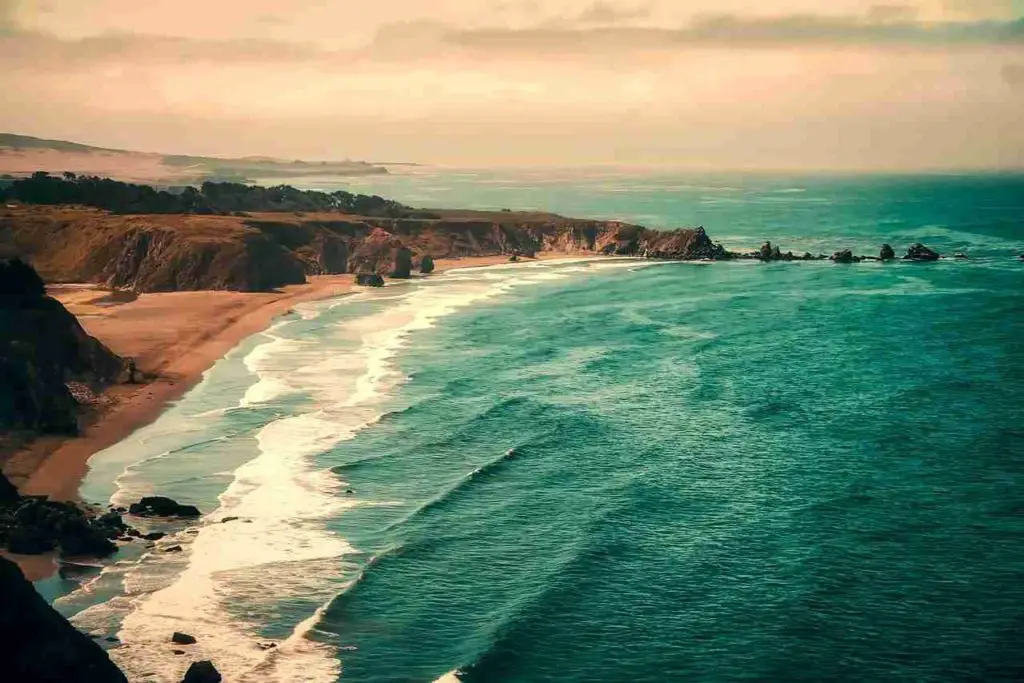
According to Shark Research Committee, an institute that has been studying sharks in the Pacific for more than 50 years, there are at least 59 species living in the Pacific Ocean, including well-known specimens such as the Great White Shark and Whale Sharks. But also some rare species, such as the near-mythical Megamouth Shark.
However, this number can be higher. There are more than 400 species on Earth, and there are no boundaries between oceans. Considering that the Pacific Ocean is the biggest in the world and it is tough to keep track of all the wildlife species in its waters, it’s possible that other species are living or passing through the Pacific.
There are fifty-nine shark species confirmed in the Pacific Ocean, and the most common are:
- Whitetip Reef Sharks
- Blacktip Reef Sharks
- Grey Reef Sharks
- Tiger Shark
- Tawny Nurse Shark
- Bull Shark
- School Shark
- Blacktip Shark
- Whale Shark
- Hammerheads (6 different species)
- Blue Shark
- Shortfin Mako Shark
- Common Thresher Shark
- Great White Sharks
- Sevengill Shark
Six different species of Hammerhead Sharks can be found in the Pacific, being them: Scalloped Bonnethead, Scoophead Shark, Great Hammerhead, Bonnethead, Smooth Hammerhead, and Scalloped Hammerhead. All species are detailed in the following section.
Related Article: Are There Sharks In Daytona Beach? (Sharks Guide)
The 59 Shark Species Of The Pacific Ocean
In the following table, you can find the complete list of all the fifty-nine species of shark confirmed in the Pacific Ocean, with details like size, scientific name, and aggressiveness level. At the end of this section, there is a detailed explanation of how the aggressiveness categories were defined.
- Most Frequently Seen: Whitetip Reef Sharks / Blacktip Reef Sharks / School Sharks
- Most Dangerous/Aggressive Species: Great White Shark / Tiger Shark / Bull Shark
- Biggest Sharks Found In The Pacific Ocean: Whale Sharks
Fun Fact: Tiger sharks, bull sharks, and white sharks are commonly referred to as “The Big Three” for their involvement in shark attacks. These species are readily identified by the victims and witnesses. In cases involving smaller requiem sharks, the species involved are seldom identified as they are harder to tell apart.
Florida Museum
| Species | Scientific Name | Maximum Size | Aggressiveness |
| Frilled Shark | Chlamydoselachus anguineus | Up to 2 m (6.5 ft) | Not Aggressive (Potentially Dangerous) |
| Broadnose Sevengill | Notorynchus cepedianus | Up to 3 m (10 ft) | Aggressive (Potentially Dangerous) |
| Bluntnose Sixgill | Hexanchus griseus | Up to 4.9 m (16 ft) | Not Aggressive (Poisonous To Eat) |
| Prickly Shark | Echinorhinus cookei | Up to 4 m (13 ft) | Not Aggressive (Harmless) |
| Spiny Dogfish | Squalus acanthias | Up to 1.5 m (5 ft) | Not Agressive (Venomous) |
| Combtooth Dogfish | Centroscyllium nigrum | Up to 51 cm (1.6 ft) | Not Aggressive (Harmless) |
| Pacific Sleeper Shark | Somniosus pacificus | Up to 4.4 m (14 ft) | Not Aggressive (Harmless) |
| Pygmy Shark | Euprotomicrus bispinatus | Up to 31 cm (1 ft) | Not Aggressive (Harmless) |
| Cookiecutter Shark | Isistius brasiliensis | Up to 42 cm (1.3 ft) | Not Aggressive (Harmless) |
| Pacific Angel Shark | Squatina californica | Up to 1.5 m (5 ft) | Not Aggressive (Potentially Dangerous) |
| Horn Shark | Heterodontus francisci | Up to 1.2 m (4 ft) | Aggressive (Potentially Dangerous) |
| Mexican Horn Shark | Heterodontus mexicanus | Up to 1.7 m (5.5 ft) | Aggressive (Potentially Dangerous) |
| Whale Shark | Rhincodon typus | Up to 18 m! (59 ft) | Not Aggressive (Harmless) |
| Nurse Shark | Ginglymostoma cirratum | Up to 4.2 m (14 ft) | Not Aggressive (Potentially Dangerous) |
| Goblin Shark | Mitsukurina owstoni | Up to 6 m (20 ft) | Not Aggressive (Harmless) |
| Ragged-Tooth Shark | Odontaspis ferox | Up to 4.4 m (14 ft) | Not Aggressive (Harmless) |
| Megamouth Shark | Megachasma pelagios | Up to 5.5 m (18 ft) | Not Aggressive (Harmless) |
| Pelagic Thresher | Alopias pelagicus | Up to 4.2 m (14 ft) | Not Aggressive (Harmless) |
| Bigeye Thresher Shark | Alopias superciliosus | Up to 4.9 m (16 ft) | Not Aggressive (Harmless) |
| Common Thresher Shark | Alopias vulpinus | Up to 5.8 m (19 ft) | Not Aggressive (Harmless) |
| Crocodile Shark | Pseudocarcharias kamoharai | Up to 1.2 m (4 ft) | Not Aggressive (Harmless) |
| Basking Shark | Cetorhinus maximus | Up to 12 m (40 ft) | Not Aggressive (Potentially Dangerous) |
| Salmon Shark | Lamna ditropis | Up to 3 m (10 ft) | Aggressive (Potentially Dangerous) |
| Great White Shark | Carcharodon carcharias | Up to 6.4 m (21 ft) | Very Aggressive (Extremely Dangerous) |
| Shortfin Mako Shark | Isurus oxyrinchus | Up to 4 m (13 ft) | Not Aggressive (Potentially Dangerous) |
| Brown Catshark | Apristurus brunneus | Up to 69 cm (2.2 ft) | Not Aggressive (Harmless) |
| Longnose Catshark | Apristurus kampae | Up to 60 cm (1.9 ft) | Not Aggressive (Harmless) |
| Swell Shark | Cephaloscyllium ventriosum | Up to 1.2 m (4 ft) | Not Aggressive (Harmless) |
| Lollipop Catshark | Cephalurus cephalus | Up to 30 cm (0.9 ft) | Not Aggressive (Harmless) |
| Peppered Catshark | Galeus piperatus | Up to 30 cm (0.9 ft) | Not Aggressive (Harmless) |
| Filetail Catshark | Parmaturus xaniurus | Up to 42 cm (1.3 ft) | Not Aggressive (Harmless) |
| Grey Smoothhound | Mustelus californicus | Up to 1.2 m (4 ft) | Not Aggressive (Harmless) |
| Sharptooth Smoothhound | Mustelus dorsalis | Up to 69 cm (2.2 ft) | Not Aggressive (Harmless) |
| Brown Smoothhound | Mustelus henlei | Up to 1 m (3.2 ft) | Not Aggressive (Harmless) |
| Sicklefin Smoothhound | Mustelus lunulatus | Up to 1.7 m (5.5 ft) | Not Aggressive (Harmless) |
| Leopard Shark | Triakis semifasciata | Up to 2 m (6.5 ft) | Not Aggressive (Harmless) |
| Soupfin Shark | Galeorhinus galeus | Up to 2 m (6.5 ft) | Not Aggressive (Harmless) |
| Tiger Shark | Galeocerdo cuvier | Up to 5.5 m (18 ft) | Very Aggressive (Extremely Dangerous) |
| Pacific Sharpnose Shark | Rhizoprionodon longurio | Up to 1.2 m (4 ft) | Not Aggressive (Harmless) |
| Scalloped Bonnethead | Sphyrna corona | Up to 92 cm (3 ft) | Not Aggressive (Harmless) |
| Scalloped Hammerhead | Sphyrna lewini | Up to 4 m (13 ft) | Aggressive (Potentially Dangerous) |
| Scoophead Shark | Sphyrna media | Up to 1.5 m (5 ft) | Not Aggressive (Potentially Dangerous) |
| Great Hammerhead | Sphyrna mokarran | Up to 6 m (20 ft) | Aggressive (Potentially Dangerous) |
| Bonnethead Shark | Sphyrna tiburo | Up to 1.2 m (4 ft) | Not Aggressive (Harmless) |
| Smooth Hammerhead | Sphyrna zygaena | Up to 5 m (16 ft) | Aggressive (Potentially Dangerous) |
| Silvertip Shark | Carcharhinus albimarginatus | Up to 3 m (10 ft) | Not Aggressive (Potentially Dangerous) |
| Bignose Shark | Carcharhinus altimus | Up to 3 m (10 ft) | Not Aggressive (Harmless) |
| Copper Shark | Carcharhinus brachyurus | Up to 3.2 m (10.8 ft) | Aggressive (Potentially Dangerous) |
| Silky Shark | Carcharhinus falciformis | Up to 3.5 m (11.5 ft) | Not Aggressive (Potentially Dangerous) |
| Galapagos Shark | Carcharhinus galapagensis | Up to 3.7 m (12.1 ft) | Not Aggressive (Potentially Dangerous) |
| Bull Shark | Carcharhinus leucas | Up to 2.1 m (6.8 ft) | Very Aggressive (Extremely Dangerous) |
| Blacktip Shark | Carcharhinus limbatus | Up to 2 m (6.5 ft) | Not Aggressive (Potentially Dangerous) |
| Oceanic Whitetip Shark | Carcharhinus longimanus | Up to 4 m (13 ft) | Very Aggressive (Extremely Dangerous) |
| Dusky Shark | Carcharhinus obscurus | Up to 3.6 m (12 ft) | Not Aggressive (Potentially Dangerous) |
| Sandbar Shark | Carcharhinus plumbeus | Up to 2 m (6.5 ft) | Not Aggressive (Harmless) |
| Lemon Shark | Negaprion brevirostris | Up to 3.7 m (12.1 ft) | Not Aggressive (Potentially Dangerous) |
| Blue Shark | Prionace glauca | Up to 4 m (13 ft) | Not Aggressive (Potentially Dangerous) |
| Whitenose Shark | Nasolamia velox | Up to 1.5 m (5 ft) | Not Aggressive (Harmless) |
| Smalltail Shark | Carcharhinus porosus | Up to 1.5 m (5 ft) | Not Aggressive (Harmless) |
The aggressiveness scale I’ve been using in all the articles was developed by Sharks Insider using data from the Fishbase library, the Florida Museum shark database, and reports from shark attacks listed in ISAF (International Shark Attack File) and GSAF (Global Shark Attack File).
- Not Aggressive (Harmless)
Self-explanatory, this category is for sharks that are considered harmless to humans.
- Not Aggressive (Potentially Dangerous)
Sharks that receive this rating do not present aggressive behavior by nature but are curious and may attack if they feel threatened/provoked. Another possibility is for sharks that are harmless by nature, but due to their large size, they can be considered potentially dangerous.
- Not Aggressive (Venomous/Poisonous To Eat)
Species that are not aggressive but are venomous to touch or poisonous to eat.
- Aggressive (Potentially Dangerous)
Such animals present aggressive behavior but are not involved in many attacks on humans.
- Very Aggressive (Extremely Dangerous)
Sharks in this category present very aggressive behavior or are involved in many attacks on humans. However, it’s important to notice that shark attacks are very rare, and despite the aggressiveness level of such species being higher than average does not mean that they will always attack.
10 Biggest Sharks In The Pacific Ocean
The Pacific Ocean is the largest ocean on Earth and is the confirmed home to almost sixty different shark species. In this section, you’ll find a detailed list of the 10 Biggest Sharks In The Pacific Ocean:
1) Whale Shark

The Whale Shark is the biggest shark in the world, reaching up to 18 meters (59 ft). It’s the largest species in the Pacific Ocean. One fun fact about this beautiful gigantic creature is that despite its size, it is not aggressive and is considered harmless to humans.
2) Basking Shark
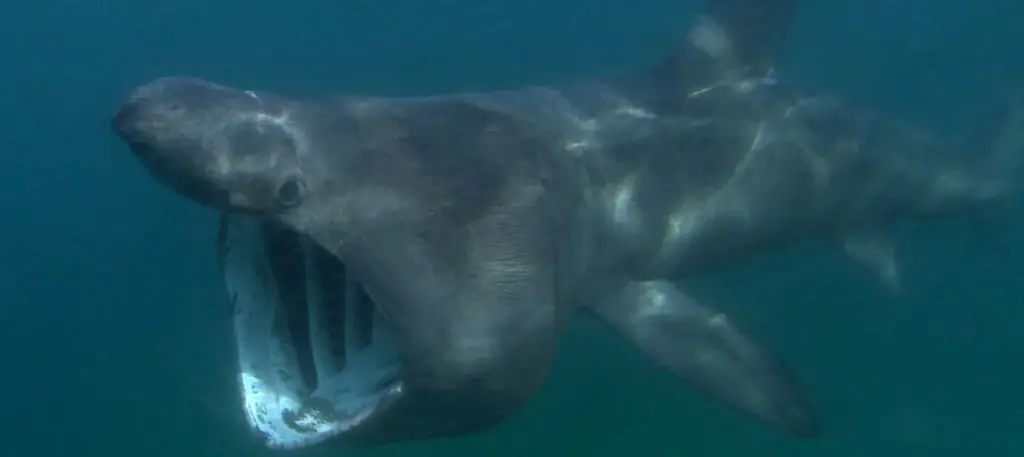
The Basking Shark is the second-largest shark on Earth (and in the Pacific). The maximum size that these animals can reach is around 12 meters (40 ft). However, there are some reports saying that they can reach up to 15 meters (45 ft).
3) Great White Shark
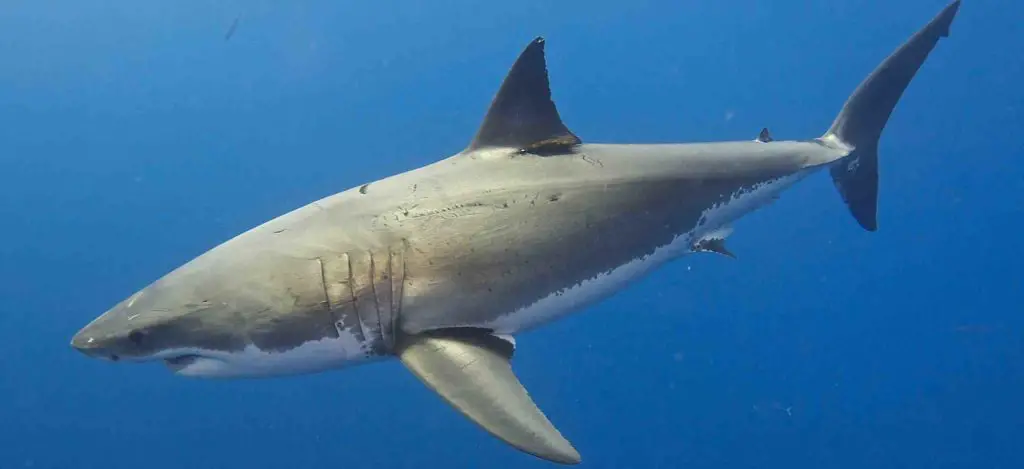
One of the world’s most known (and feared) sharks, especially because of the classic movie Jaws. It’s one of the largest shark species, with a maximum size of about 6.4 meters (21 ft). However, there are unconfirmed reports of white sharks growing to 7 meters (23 feet).
4) Great Hammerhead Shark
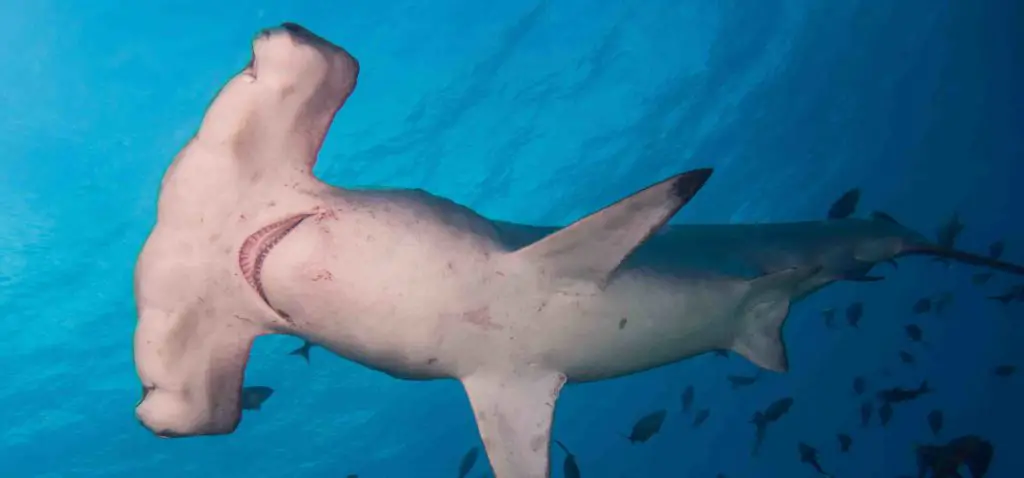
One of my favorite sharks, this beautiful creature is easily recognizable because of the shape of its head. It can be found in different regions and is the fourth-largest Pacific Ocean shark species, reaching an incredible size of 6 meters (20 ft).
5) Goblin Shark
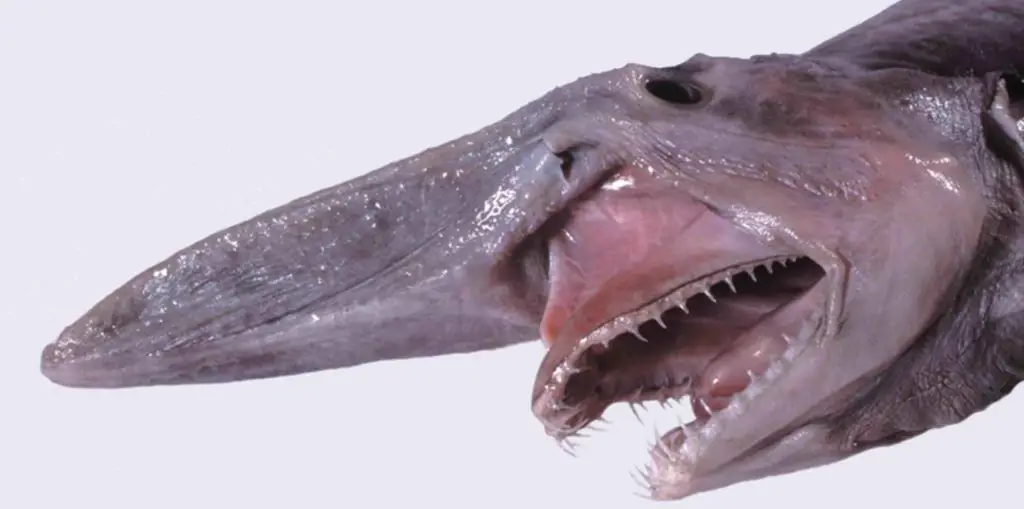
Ok, maybe you are a tough person who is not easily frightened or fearless. But you have to confess that this creature is super scary. Despite the terrible look, the Goblin Sharks are considered harmless to humans (at least in terms of attacking). However, it is a large animal, reaching up to 6 meters (20 ft).
6) Thresher Shark
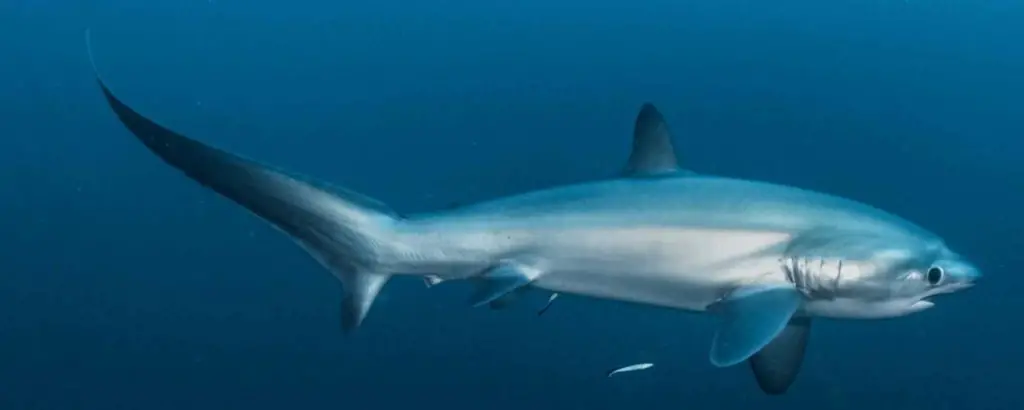
The Thresher Shark (also called Common Thresher Shark) is a beautiful and large animal, reaching up to 5.8 meters (19 ft). They have a remarkable unique characteristic which is the long upper lobe of their caudal fin, used to stun their prey (usually small fishes). It’s the sixth-largest shark in the Pacific.
7) Megamouth Shark
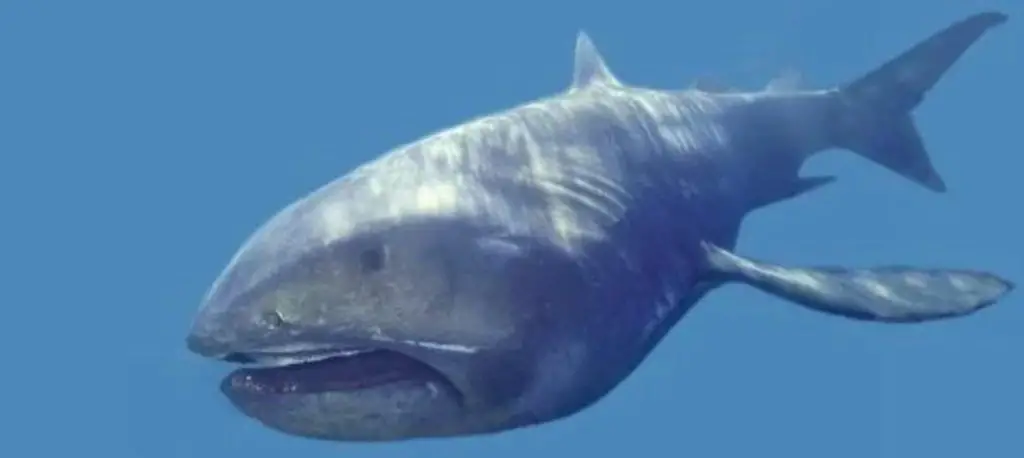
This nearly-mythical creature was only discovered in 1976, despite some reports of its existence before. But there is a reason for it: this is a deepwater shark, and sightings are rare. Since its discovery, fewer than 100 specimens have been observed or caught. Its maximum reported size is 5.5 meters (18 ft).
8) Tiger Shark
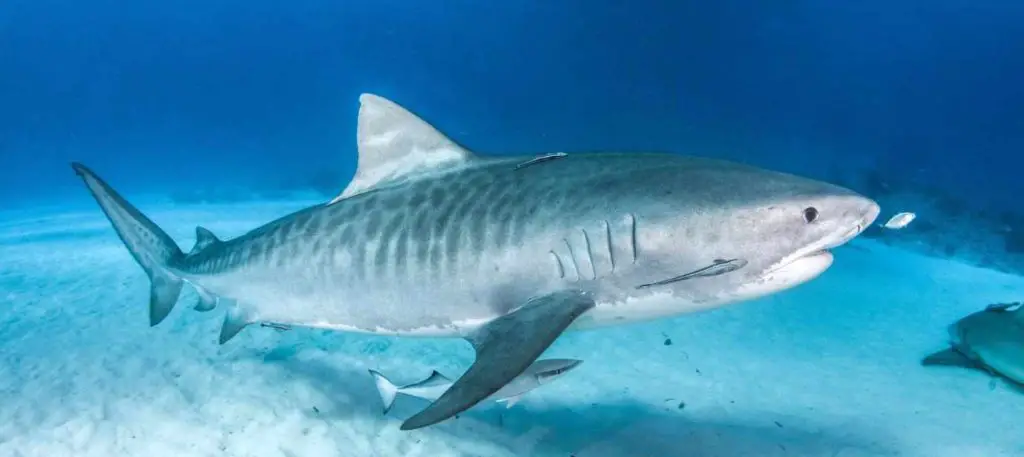
In my opinion, Tiger Sharks are the most beautiful. They are named for their distinctive color pattern, with a gray body with dark gray vertical bars, like a Tiger. These animals are among the largest sharks in the Pacific Ocean, reaching up to 5.5 meters (18 ft).
9) Bluntnose Sixgill Shark
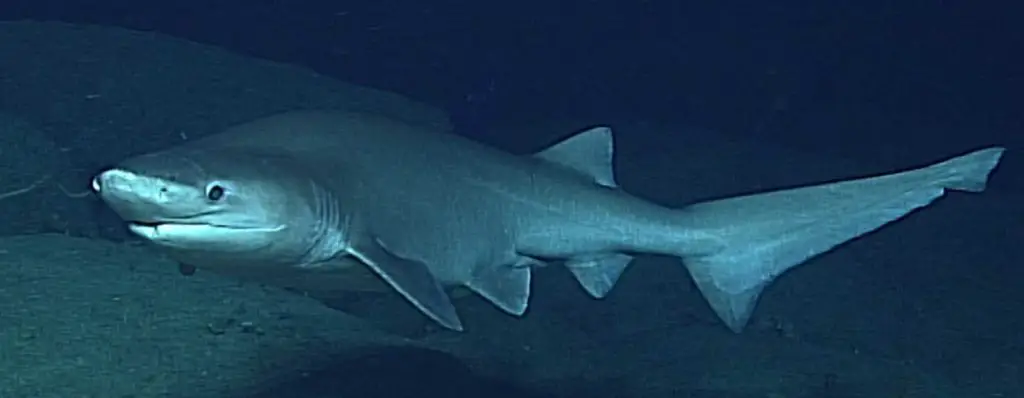
The Bluntnose Sixgill Shark is also known as the Cow Shark. This shark has a large body, a long tail, a blunt and wide snout, and small eyes. It is found in tropical and temperate waters worldwide (including the Pacific Ocean). It can grow up to 5 meters (16 ft), but there are reports of some specimens with almost 6.1 meters (20 ft).
10) Smooth Hammerhead Shark
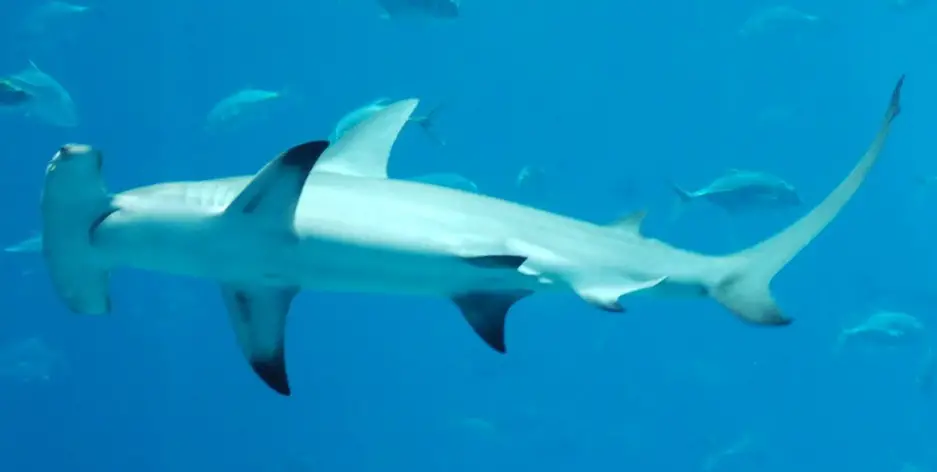
To close the list of the 10 largest sharks in the Pacific Ocean, another beautiful animal, the second hammerhead on the list. This is the Smooth Hammerhead Shark, a large animal that can easily reach incredible 5 meters (16 ft) in length and weigh up to 400 kg (880 pounds).
Great White Sharks In The Pacific Ocean
The White Shark (or Great White) is one of the best-known sharks and can already be considered a Hollywood star for being portrayed in dozens of movies, including the classic Jaws. It is one of the largest sharks, reaching up to 6.4 meters (21 ft). Despite beautiful, it’s also dangerous: according to the ISAF, the White Shark has been credited with more fatal attacks on humans than any other shark species.
According to the Shark Research Committee, the Great White Shark’s known range along the Pacific Coast of the United States and Canada extends from Imperial Beach, San Diego County, California, near the Mexican border, in the south, to the northwest Bering Sea off the Aleutian Islands, Alaska, in the north. But they can also be found in the South of the Pacific Ocean, even in Chile.
Related Article: Are There Sharks In Dominican Republic? (Full Guide)
Are There Shark Attacks In The Pacific Ocean? (New Research)

The Pacific Ocean is the largest ocean on Earth and home to at least 59 species of shark. Lying between America, Asia, Australia, and Antarctica, the number of confirmed shark attacks in the Pacific was unknown until the research was done for this article.
At least 1189 shark attacks occurred in the Pacific Ocean. Most attacks in the Pacific took place in Australia, in the regions of Queensland, New South Wales, Victoria, and Tasmania. The United States is second place, with 345 shark incidents in states covered by the waters of the Pacific.
For this article, I’ve created a new research, collecting data from ISAF (Internation Shark Attack File) to determine the approximate number of shark attacks in the Pacific Ocean. There are some great sources of attacks divided by country, but this is the first available source (at least that I’m aware of) showing the number of shark attacks considering only countries (or parts of countries) covered by the Pacific.
A good example is the United States, the place with more shark attacks in the world (1563 attacks). But if you consider only the attacks that occurred in states converted by the pacific (California, Oregon, Washington, Hawaii, and Alaska), the number is way low: 345. In the following table, you can find the final numbers of shark attacks in the Pacific Ocean.
| Country | Attacks |
|---|---|
| Australia | 522 |
| United States | 345 |
| Papua New Guinea | 48 |
| New Zealand | 42 |
| Fiji Islands | 23 |
| Mexico | 22 |
| Central America | 21 |
| New Caledonia | 19 |
| Japan | 15 |
| Ecuador | 13 |
| Hong Kong | 13 |
| Solomon Islands | 11 |
| Phillipines | 11 |
| Indonesia | 11 |
| Vietnam | 10 |
| Canada | 9 |
| Marshall Islands | 8 |
| Kiribati | 8 |
| French Polynesia | 7 |
| Thailand | 5 |
| Tonga | 4 |
| Federated States of Micronesia | 4 |
| American Samoa | 4 |
| Russia | 3 |
| Taiwan | 3 |
| Wake Island | 2 |
| Vanuatu | 2 |
| Guam | 2 |
| South Korea | 1 |
| China | 1 |
| Total | 1189 |
Related Questions
Do sharks live in the Pacific Ocean? There are at least 59 species of shark living in the Pacific Ocean. However, this number can be even higher, as there are about 400 species worldwide and no boundaries between oceans. Approximately 1189 shark attacks took place in the Pacific Ocean.
Are there great white sharks in the Pacific Ocean? Great White Sharks can be found in the Pacific Ocean, especially in the North, in shallow coastal waters from the Gulf of Alaska to the Gulf of California. However, there is confirmation of the Great White Sharks way more to the South, even in Chile.
Sources
- Shark Attack Data: https://www.sharkattackdata.com/
- Global Shark Attack File (GSAF): https://www.sharkattackfile.net/
- Florida Museum: https://www.floridamuseum.ufl.edu/
- International Shark Attack File (ISAF): https://www.floridamuseum.ufl.edu/shark-attacks/
- Shark Research Committee: http://www.sharkresearchcommittee.com/
- Fishbase: https://www.fishbase.org.au/v4
